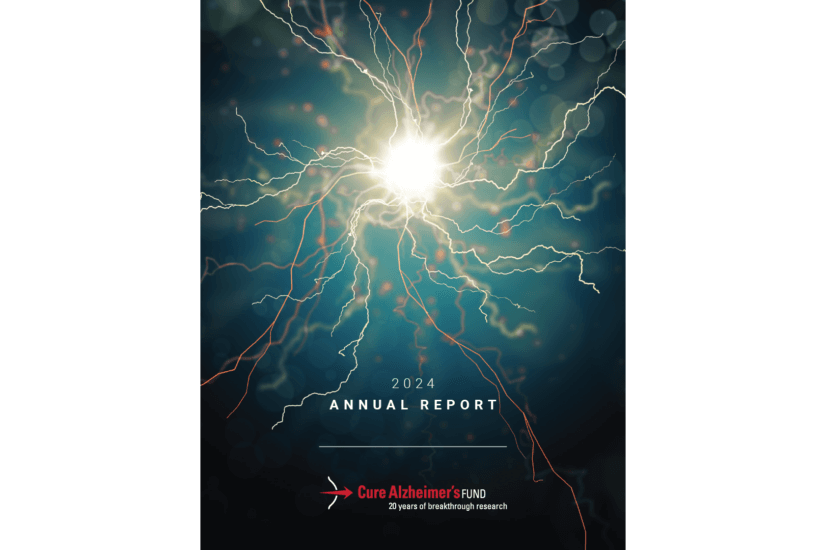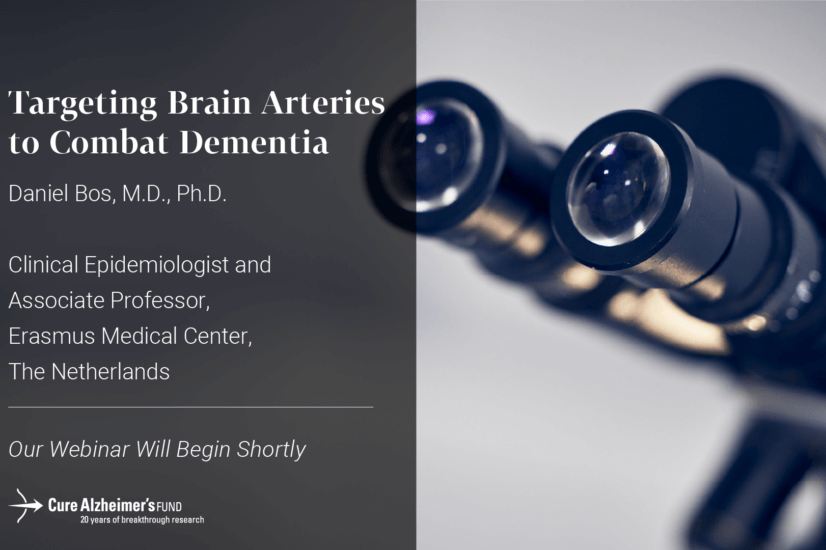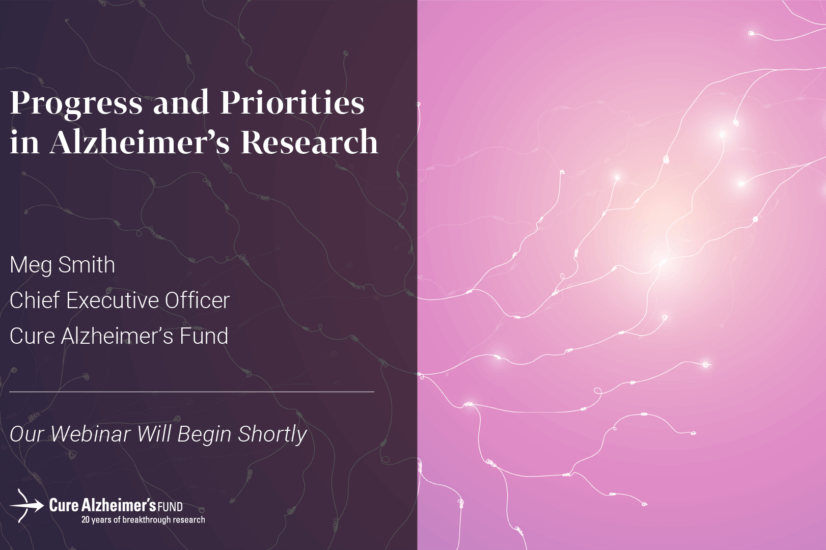Getting to a Cure
Why do we need a National Strategy?
- The cost of care for Alzheimer’s patients will overwhelm Medicare and Medicaid if not checked within the next few years.
- Over the past two decades, the modern era of AD research has been made possible by the discovery of AD genes. Studies of the four known AD genes have driven drug discovery and development. Up until the summer of 2008, the field was aware of only four AD genes, which account for approximately 30% of the genetic effects on the disease. With the identification of the additional Alzheimer’s genes, researchers will be able to understand the other 70% of the genetic effects and how they lead to AD pathology. This critical information can then be used to guide the discovery and development of novel and effective therapies for treating and preventing AD.
How much work has already been completed on this strategy?
- Researchers supported by Cure Alzheimer’s Fund have identified 70 new genes that affect risk for regular or “late onset” AD as of the summer of 2008. The four top genes among the 70 were published in the Fall, 2008 and this study was named one of the “Top Ten Medical Breakthroughs of 2008” worldwide by Time Magazine. Several more genes have been identified that affect risk for early onset. Therefore, there is great and recent progress at the base of the Roadmap pyramid, giving rise to the need for rapid follow up on those discoveries.
- Several promising drugs based on knowledge gained from the first four genes are in trials for human use, but early indications are that none of these by themselves or in combination will be able to slow, stop or reverse the disease in any significant part of the AD population.
- Current clinical trials of drugs aimed at retarding disease progression in AD involve therapies that curb the accumulation of the A-beta peptide in the brain by either promoting its clearance or turning down its production. Other therapies are aimed at preventing the conversion of tau protein into neurotoxic tangles. Many of the most promising clinical trials would not have been possible without the identification and characterization of the first four known AD genes, and by understanding the effects of the newly identified genes we will be able to move much more rapidly to arrest the AD pathology.
What is the time frame from funding to the availability of an effective therapy?
The Strategy posits a ten year time frame to eradicate the disease assuming an order of magnitude increase in federal support of AD research.
Does the recent mapping of the AD genome by Cure Alzheimer’s Fund-supported research make this strategy more feasible?
Yes; absolutely. Awareness of multiple new gene targets provide researchers with many more “shots on goal” to develop effective therapies. In addition every new gene discovered increases the future ability for reliable prediction of risk for AD prior to getting the disease. As effective therapies for the prevention of AD are developed, we will someday be able to employ a “pharmacogenomic” and “personalized medicine” approach to curing AD by “early prediction-early prevention” based on the genetics of the disease.
There are always a lot of articles/ press releases about breakthroughs in AD research. What are the ones that offer the most hope? How do these make this strategy the most logical path to follow?
- Many of these “breakthroughs” are either “old news” repackaged for public relations/funding value, “discoveries” of limited, incremental value, or findings that are easily accessible to the public who buy newspapers. Many others are valuable but unrelated to each other and with no mechanism to prioritize and sort discoveries to incorporate and further develop those that will help to accelerate progress toward a cure.
- The most important and noteworthy research is generally complicated and not as easily accessible for the media and their subscribers. So, many of the most important findings in AD research are not highlighted in the media.
- In any event, all research discoveries covered in the press should be accompanied by publication in peer-reviewed journals or minimally following presentation at public scientific conferences, before being made available to the popular press.
- A Research strategy agreed upon by a significant number of the AD researchers can help to prioritize and target new discoveries for further development.
Cost
What is this going to cost?
- The amount will vary from year to year, and will probably balloon in the middle years when intensive clinical trials should be underway. However, a very general estimate is that $50 billion at roughly $5 billion per year over 10 years will be required. In this manner, the federal government can accelerate:
- Basic (foundational) research into the causes of AD, e.g. genetic research and studies of the normal and pathological roles of the genes and proteins found to play a role in AD pathology.
- Translational research into how basic lab discoveries can be translated into novel therapeutics that slow, stop, or reverse disease progress.
- Drug discovery efforts both at academic institutions and in collaborations between academia and industry. It will be necessary to take what we learn in basic and translational studies of AD-associated genes and proteins and integrate this knowledge into “smart” screens for novel therapies aimed at treating and preventing AD. These therapies could include small molecule drugs, biological products, e.g. recombinant proteins and antibodies, or even supplements. Recent decreases in private funding of biotechnology companies have transferred much of the onus for drug screening back on academia.
- Drug development through clinical trials. Clinical trials will need to be carried out by both drug companies and academia. In the latter case, clinical trials for promising supplements or off-patent drugs that offer little profit incentive for the pharmaceutical industry would need to be tested by academic institutions, largely with federal funding. For a clinical trial, federal funding would also be necessary for coordinating and helping to execute AD clinical trials at academic centers, e.g. NIH-funded AD clinical centers around the U.S.
- The cost of drug development from basic research to translational studies to drug discovery to drug development and clinical trials onward through the marketing approval phase costs approximately $800 million per drug (DiMasi, Hansen, Grabowski et al, Journal of Health Economics, October, 2002.) Since only one in ten drugs generally succeeds and given the likely “cocktail” of drugs that we will need to test before we can effectively slow, stop, or reverse AD, we can assume that the federal government will need to assist in the discovery and development of hundreds of candidate therapies over the next decade, from basic research all the way through to coordinating clinical trials. We can no longer wait for the pharmaceutical industry to do this on its own. The federal government, non-profit foundations and academia must step in and proactively make a cure via “early prediction-early prevention” a reality over the next decade. Otherwise, the effects on our healthcare system will be devastating.
What is the balance between the private and public sectors in funding this roadmap?
Public sector and nonprofit funds usually support the earlier stages of development but can facilitate progress toward a cure all the way through to clinical trials, as described above. In this case, the cost would approximate $30-50 billion for public and nonprofit support. Drug development is usually funded by private pharmaceutical companies at the rate of approximately $1 billion per drug.
Who decides how to allocate the money for this?
- Within the public sector, adoption of a National Research Strategy for Alzheimer’s Disease would help prioritize research through NIH funding. Private non-profits would be encouraged to contribute to progress described by the strategy.
- Pharmaceutical companies will be more likely to invest in “Strategy-approved” drugs as much of the risk of drug development will have been reduced. We must also be ready for the likelihood that drug companies will only foster trials of drugs that would be profitable. Federal and private funding would be needed to test promising non-profitable, e.g. off-patent, therapies and supplements.
Collaboration/Duplication of Efforts
Are there other strategies/roadmaps to a cure? If so, why should we follow this one?
- NIH has embarked on a similar path, but has stalled for lack of funding. Private nonprofit funding has already achieved a major milestone by identifying most if not all the genes for late-onset AD and is finding more genes for early onset AD.
- Other strategies are emerging which emphasize more awareness, aid to patient families and organization of governmental resources to attack the disease in a more concerted way. The Cure Alzheimer’s Fund National Research Strategy specifically targets the kind and progression of research necessary for the most rapid development of effective therapies.
What is the role of the pharmaceutical industry in this?
Pharmaceutical companies are most efficient at bringing well-developed compounds from the translational and drug discovery phases into the elaborate and expensive human trials. Better focus of research at the Foundational and Translational stages will provide pharmaceutical companies with lower risk, higher potential compounds for clinical trials and eventual manufacturing and distribution.
Managing the Strategy
How will this research project be implemented? Who is involved in it? Who designed it?
- A National Research Strategy will only be effective if adopted by the relevant sectors of the National Institutes of Health and related government agencies. Adoption of such a Strategy would not mean exclusion of other science-worthy AD-related projects, but would mean a priority on projects defined within the Strategy’s broad parameters. A consolidation of government entities now charged with funding research for Alzheimer’s disease, along with a panel of leading AD researchers would provide guidance for awarding federal dollars for Alzheimer’s disease research prioritized by the National Research Strategy.
- Nonprofit AD-focused funders will be encouraged through funding consortia and joint-project funding to prioritize projects that fall within the Strategy.
What are the controls on spending and progress?
- Normal procedures for management of research dollars will be followed through NIH grants and the requirements of private funders.
- It will likely be necessary for the NIH to take the best internal AD experts from each Institute, e.g. the NIA, NINDS, and NIMH to build a National AD Research Oversight Office that can manage the distribution of funds for the National Research Strategy.
Will the same people be involved at each step on the roadmap or is it different people?
The consolidation of the relevant government entities into an Alzheimer’s task force, along with the panel of expert Alzheimer’s researchers would reflect expertise at various stages of the strategy, including the drug development/trials/manufacturing stages.







